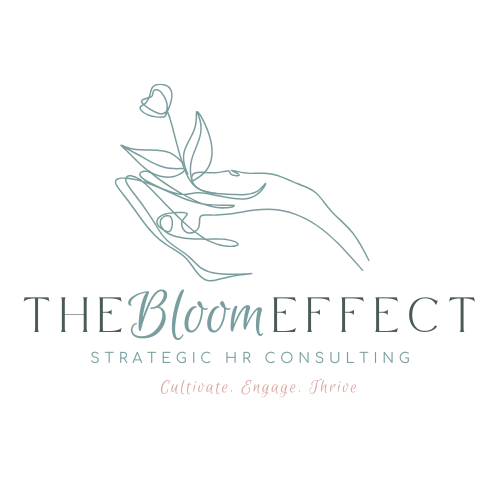
Thriving in 2025 — creating a strategic approach to cultivate a team that blooms in a world that is constantly changing. How the Bloom Effect can help you get ready.
3 major HR challenges in 2025
-

Critical L&D
The business landscape in 2025 is marked by rapid change driven by technology (like AI and automation), shifting workforce expectations (especially from Gen Z and Millennials), intense global talent competition and uncertainty (political shifts and regulation changes), and the need for greater business agility. In this environment, strategic investment in Learning and Development (L&D) is no longer optional but a critical necessity for organizational success and survival.
Traditional L&D Fails: One-size-fits-all, poorly aligned, and event-based training is ineffective and fails to meet modern needs.
Many current L&D approaches fall short, often relying on outdated, one-size-fits-all models that lack alignment with business goals, fail to integrate learning into daily work, and offer limited personalization or accessibility. This contrasts sharply with the needs of a modern workforce facing a shrinking "skills half-life" (where skills quickly become obsolete) and demanding continuous growth and purposeful work.
Aligning L&D initiatives directly with business strategy and culture.
Auditing the current state and conducting thorough needs assessments focused on performance and skills gaps.
Investing strategically in learning and development initiatives tailored to your organization.
Empowering managers to act as coaches and growth enablers.
Personalizing development with employee-driven options and flexibility.
Tracking outcomes with clear metrics focused on behavior change, business impact, and ROI.
Those that prioritize building a growth-centered culture will gain a significant competitive edge in innovation, talent retention, and adaptability.
Are you prepared to tackle the challenges of this new landscape?
Check out our report on the state of L&D in 2025, and our L&D Toolkit to assess your team against the most in-demand skills of 2025.
-

The Age of AI
Artificial intelligence (AI) - you either love it, hate it, or fear it.
Either way, it’s is rapidly entering workplaces, offering potential for increased efficiency and innovation but also posing risks like dehumanization, bias, and job insecurity. Responsible AI implementation must prioritize the human experience, viewing AI as a tool to augment human capabilities (like judgment, creativity, and empathy) rather than simply replace workers. Success hinges on fostering psychological safety. By adopting human-centered principles, establishing robust governance, managing risks proactively, and investing in employee upskilling and well-being, organizations can harness AI's benefits while creating more engaging workplaces and calming employee fears associated with job insecurity. Ultimately, when employees thrive alongside AI, the organization succeeds.
The most effective and ethical approach views AI as a tool to enhance human skills (creativity, judgment, empathy) rather than solely focusing on replacing human tasks.
Employee adoption and the success of AI initiatives depend heavily on a psychologically safe environment. Fear of job loss, surveillance, and lack of transparency are major threats.
Fairness, transparency, accountability, and human oversight must guide AI strategy and deployment.
Responsible AI requires a systematic approach including readiness assessments, clear governance structures (like ethics committees), defined accountability, human oversight protocols, explainability efforts, and continuous feedback loops.
Organizations must anticipate and mitigate risks like bias amplification, privacy violations, skill erosion, and legal/reputational damage.
Leadership sets the tone and is critical in championing a human-centered vision, prioritizing ethical safeguards, investing in people, and monitoring both performance and employee well-being.
Is your organization ready to implement AI responsibly and in a way that enables your people to flourish or wilt?
-

The Burnout Epidemic
Workplace burnout has evolved from an individual concern into a critical organizational crisis in 2025. Defined by the WHO as an occupational phenomenon stemming from unmanaged chronic workplace stress , it manifests as exhaustion, cynicism, and reduced efficacy. Persistently high rates since the pandemic indicate it's now a chronic issue. The primary drivers are systemic and organizational, including toxic cultures, excessive workloads, lack of control, and inadequate support. Burnout carries significant costs, impacting employee health, increasing turnover, reducing productivity (including presenteeism), and damaging the employer brand. Addressing burnout requires a strategic shift from focusing solely on individual resilience ("self-care") to implementing organizational-level changes and fostering a culture of "organizational care".
Burnout is Systemic: It's an occupational phenomenon rooted in the work environment, not just individual stress.
Significant Consequences: Burnout leads to declines in mental and physical health, increased absenteeism and presenteeism, higher turnover, decreased productivity and innovation, and long-term damage to employer brand and trust.
Prevention is Organizational: Effective prevention requires systemic changes in work design, leadership, and culture.
Recovery Needs Support: Supporting employees experiencing burnout requires individual resources (mental health services, coaching) and supportive team/organizational structures (manager training, re-entry protocols).
How are you fixing burnout at the root, and helping your team recover once and for all?
Read more below on the signs of burnout, and what you can do to respond and prevent burnout.
Head to our store to download our burnout risk assessment toolkit and see where your company falls on the spectrum so you can create a recovery plan today!




